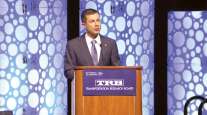Senior Reporter
USDOT Updates National Safety Strategy

[Stay on top of transportation news: Get TTNews in your inbox.]
Additional safety strategies for the nation’s mobility networks were recently announced by the U.S. Department of Transportation as part of its comprehensive plan.
A framework known as the “Safe System Approach,” was endorsed to create multiple layers of protection for the public via safer people, roads and vehicles, speed management, and improvements to post-crash care. “The ‘Safe System Approach’ holistically builds and reinforces multiple layers of protection to both prevent crashes from happening in the first place, and minimize the harm caused to those involved when crashes do occur,” per background USDOT provided.
The strategy was included in the department’s National Roadway Safety Strategy, which was unveiled at the start of the year.
We live in an era when it is safer to fly in an airplane 30,000 feet above the ground than it is to walk down the street.
We must do everything we can to cut fatalities on our nation's roadways. — Secretary Pete Buttigieg (@SecretaryPete) October 15, 2022
“At a time when it is safer to fly across the country than it is to walk across town, we must all act to address the crisis on our nation’s roadways,” Transportation Secretary Pete Buttigieg said in a statement accompanying the update on Oct. 14. “With new resources from President [Joe] Biden’s bipartisan infrastructure law, we are taking critical steps to save lives on our roadways.”
Other updates to the safety strategy include enhanced safety monitoring of new technologies in motor vehicles by the National Highway Traffic Safety Administration, and the consideration of applications for $1 billion in roadway safety grants for regional, tribal and local governments. Additionally, the Federal Highway Administration recently encouraged states to implement “complete streets” concepts prioritizing safety for every transportation mode.
In its report to Congress, FHWA indicated, “Complete Streets provide users with essential access to the transportation network, regardless of mode choice. Access, or connectivity, determines how easily people can move throughout the transportation system. At its simplest level, network connectivity addresses how travelers can move safely and easily from place to place.”
“Safety and comfort for those who use transit, walk, bike or roll are integral to the objective of providing connections and access for those who choose to use those modes,” per FHWA’s report from March titled, “Moving to a Complete Streets Design Model: A Report to Congress on Opportunities and Challenges.”
Overall, USDOT’s strategy responds to NHTSA data estimating nearly 43,000 traffic fatalities in 2021, marking a 10.5% increase from the year prior. “As the result of effective safety interventions and adoption of new technologies traffic fatalities had been on the decline in the [United States],” according to USDOT. “But progress has stalled in the last decade, and during the first two years of the pandemic moved in the wrong direction.”
Want more news? Listen to today's daily briefing above or go here for more info
Last year’s $1 trillion Infrastructure Investment and Jobs Act (IIJA), dedicated funds for resolving safety woes on the nation’s roadways. Specifically, the law proposes achieving USDOT’s goal of arriving at zero roadway fatalities. “Although it is heartening to see a projected decline in roadway deaths in recent months, the number of people dying on roads in this country remains a crisis,” Ann Carlson, NHTSA acting administrator, said last month. “Now is the time for all stakeholders, including states, local transportation entities, industry, nonprofits and others, to leverage the significant funding and tools provided under the president’s bipartisan infrastructure law and join with USDOT in implementing the National Roadway Safety Strategy’s safe system approach, so we can turn the tide on years of increasing deaths.”
The IIJA, referred to as the bipartisan infrastructure law, was enacted by President Joe Biden Nov. 15.




